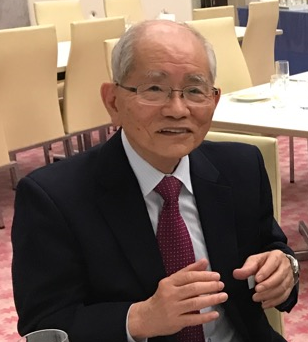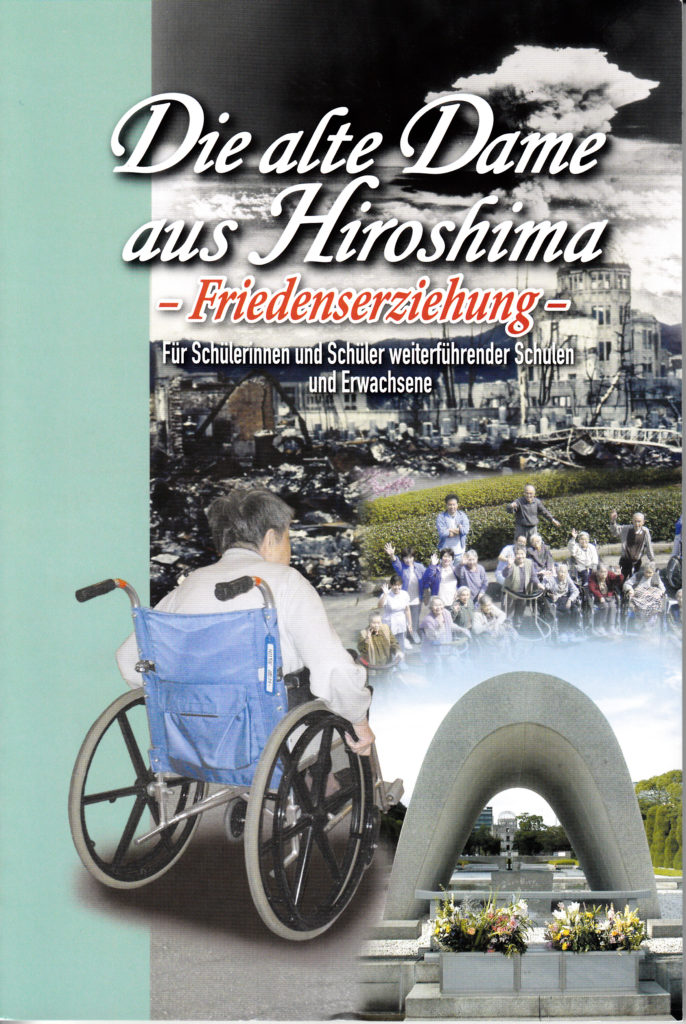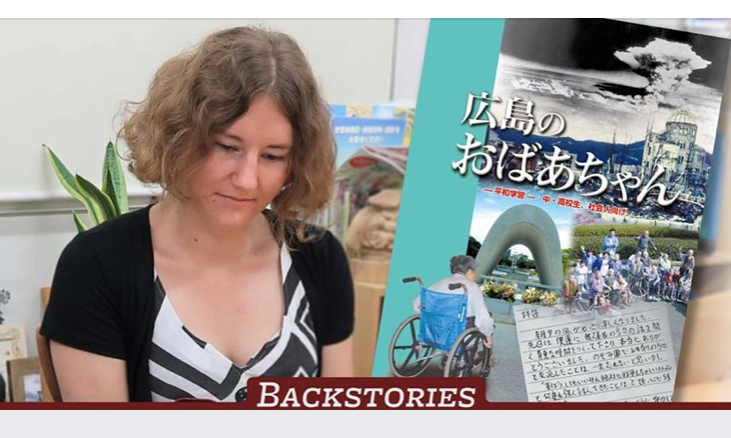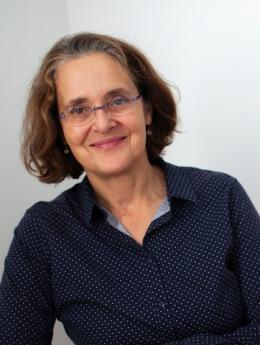A Newly Released Book
The German version of a medical book for general readers written by a doctor who has treated hibakushas’ diseases throughout his life.
Kamada, Nanao. Die alte Dame aus Hiroshima ─Friedenserziehung─ Für Schülerinnen und Schüler weiterführender Schulen und Erwachsene.

Übersetzerin, Victoria Kropp (translated from Japanese by Victoria Kropp).
Veröffentlicht von der japanischen Sektion von IPPNW (Internationale Arzte für die Verhütung des Atomkrieges). Hiroshima: JPPNW c/o Hiroshima Prefectural Medical Association, 2020.

Following the original Japanese, English, and French versions, the German translation was newly published on October 26, 2020. The author, Dr. Kamada, Nanao is the leading expert on the aftereffects caused by atomic bombing. He has put all his energy into the treatment of hibakushas’ diseases for more than a half century. The aim of this book is for the younger generation and general readers to understand survivors’ long-term struggle against the diseases. The author employs good ways for the readers’ better understanding of hibakushas’ long-term struggles against the diseases.
This book, for example, consists of three sections, Past, Present, and Future, offering ample visual aids such as charts, graphs, and pictures. Furthermore, upon opening the book you will find a dialogue in Hiroshima dialect between an elderly, female hibakusha and elementary and junior high school students on the left page with further details for university students and teachers on the right. The author wrote this book based on his knowledge of medical sciences he has acquired since 1945. However, as far as we know, this is the only book in which the author explains medical effects of the atomic bombing plainly and fully to a wide range of age groups.
Responding to NHK’s interview, Victoria Kropp, the German translator, emphasizes the importance of reading atomic bomb literature in native languages. She says that the story she translated into German brought her father to tears and that he was so moved precisely because he was able to read the account in his native language. Dr. Kamada hopes that this book will be translated into various languages and contribute to the peace activities of many people around the world.

NHK WORLD JAPAN Backstories- German student tells the story of “Hiroshima’s Grandma”
https://www3.nhk.or.jp/nhkworld/en/news/backstories/1346/
*Free Download PDF e-books:
The Original (Japanese)
http://www.hiroshima.med.or.jp/ippnw/books/index.html
English version:
https://www.ippnw.org/pdf/book-one-day-in-hiroshima.pdf
French version:
https://www.ippnw.org/pdf/La%20vieille%20dame%20Hiroshima.pdf
*Information— JPPNW (Japanese Affiliate of IPPNW) c/o Hiroshima Prefectural Medical Association:
Popular Protest in Post War Japan: The Antiwar Art of Shikoku Gorō
A new digital exhibit of Shikoku Gorō’s pictorial arts with poems is open to the public. This website provides readers with the full commentary on Shikoku’s works based on a thorough review of reliable sources. Such a complete, online introduction to Shikoku’s post-war activities is unprecedented in any language.

About Prof. Ann Sherif:
https://www.oberlin.edu/ann-sherif
About Shikoku Gorō (1924-2014)
Shikoku Gorō, a native of Hiroshima, was an artist, poet, and antiwar activist. He was interned for three years in Siberia. After returning home in 1948, he knew that his younger brother had died in the atomic bombing of Hiroshima. Shikoku’s postwar life started with these two bitter experiences.
The Website
On the Overview page, Sherif gives three questions to readers of this website in advance:
- How did Shikoku and other artists make their art and poetry visible and meaningful, despite their exclusion from the art and literary establishments?
- How did these books, pictures, and poems challenge viewers to envision their hometown in different ways from the atomic desert imagined from afar?
- How did Shikoku and other local activist artists advocate for social justice and oppose the nuclear arms race in the face of unresolved debates about Japan’s militarist and imperialist past?
Sherif gives these questions to readers not only to help them to appreciate Shikoku’s artworks, but also because she hopes the website will help them find the answer for a more universal question about what role visual arts and poetry can play in antiwar activities.
Shikoku’s postwar activities are divided into three main areas:
- Atom Bomb Poetry Collection. Shikoku’s antiwar activities in Hiroshima started as a member of “Our Poems Circle”. One of their activities was guerrilla art. In collaboration with other artists and writers, he put up street poem posters despite strict control by the police in the early 1950s.
- The Angry Jizo. Shikoku Gorō became famous in Japan for his illustrations of the children’s book Okori Jizo or The Angry Jizo. This book was created in collaboration with another Hiroshima native who lost family in the bombings, prolific children and young adult author Yamaguchi Yūko (1916-2000). Shikoku’s work as an illustrator contributed to conveying children’s war experiences to the next generation.
- Hiroshima Sketches. Shikoku left many sketches of Hiroshima. Sherif adds her explanations of historical and social backgrounds to each sketch.
“Expressing Hiroshima”
Many aspects of Shikoku’s life and work are available in this rich section of the website. For example, his entire body of work is shown in detail in “Expressing Hiroshima” which contains details about his drawing style and techniques, painting exhibitions, work on the Cenotaph, and much more.
Artistic Legacy
Since Shikoku’s death in 2014, supporters have honored Shikoku’s legacy with various performances and displays. An actress, Kiuchi Midori, read Shikoku’s anti-war poems aloud while showing his pictures on the screen. A drama group performed a play, Hiroshima no Kawa (Rivers in Hiroshima), which depicts how activists protested the Japanese government’s rearmament policy during the Korean War era. Shikoku’s art also has been shown to many people in Japan and abroad through exhibitions, publications of books, and media coverage.
Future plans for this project
Sherif expects the website to be used as teaching material for peace education and English language learning. Her wish meets Shikoku’s intention. According to his son, Shikoku Hikaru, Shikoku used to say that he didn’t expect people just to appreciate his artworks but to use them as means for antiwar activities.
(Tomoko Nakamura, Nancy Meyer)